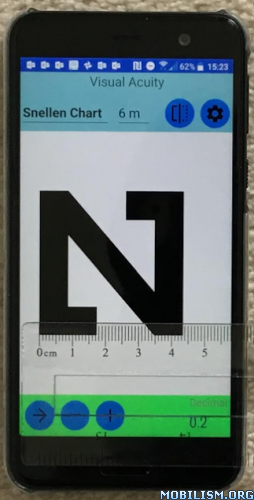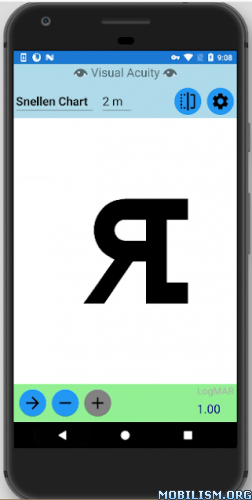Visual Acuity Charts v2.1.2 build 59 [Paid]
Requirements: 4.2+
Overview: Prevention better than cure. Designed for children older than 6, parents with young children, and general practitioners, this app displays optically precise optotypes of eye charts for you to detect nearsightedness or myopia accurately and early.
Prevention better than cure. Designed for children older than 6, parents with young children, and general practitioners, this app displays optically precise optotypes of eye charts for you to detect nearsightedness or myopia accurately and early.
Rather than taking eye exams annually, you can check your visual acuity frequently with this app. For example, if you have young children to take care of, you may test their visual acuity monthly, fortnightly or weekly, so you can take preventive measures and seek help from medical professional early to prevent pseudomyopia from becoming myopia, or prevent nearsightedness from getting worse.
Supported Eye Charts:
1. Snellen Chart, with C, D, E, F, H, K, N, P, R, U V and Z, as defined in BS 4274-1:2003
2. Tumbling E Chart
3. Landolt C Chart
4. ETDRS Chart, with C, D, H, K, N, O, R, S, V, and Z
5. HOTV Chart
6. ETDRS European-wide Chart, with H, K, O, E, P, X, B, T, M and A
7. LEA Symbols for preschool-age children
8. Numbers
ETDRS chart with LogMAR notation is actually LogMAR chart.
Predefined Test Distances:
* 6, 5, 4, 3, and 2 meters
* 20, 15, 12, 10, 6 feet
And an arm’s reach distance may be defined in Settings.
At exactly 6 meters away from the “patient”, the optotypes on the 6/6 line (Decimal 1.0 or LogMar 0.0) shall subtend 5 minutes of arc, which means that the chart should be sized such that these optotypes are 8.73mm tall, and the topmost (Snellen Fraction 6/60, Decimal 0.1, or LogMar 1.0) optotypes should be 87.3 mm tall. At exactly 20 feet away from the “patient”, the topmost optotypes should be 88.7 mm tall, because 20 feet equals 6.096 meters.
Voice Hint is available for a "doctor" wearing a headphone when observing the responses from the "patient".
Scenarios:
1. "Doctor" and "Patient".
2. Self-diagnosis with a mirror.
3. Self-diagnosis within arm’s reach
Notations:
1. Decimal (0.50)
2. Fraction (20/40)
3. LogMAR (0.30)
4. Fraction (5/10)
5. Fraction (6/12)
6. MAR (2)
7. VAS or VAR (85)
All charts in any VA notation follow the LogMAR design recommended by the International Council of Ophthalmology (ICO) to address design flaws in original Snellen chart.
Modes:
1. Autoplay
2. Manual
In Autoplay, the app calculates the score. For LogMAR notation, the score is (LogMAR value of the best line read) + 0.02 x (number of optotypes missed). For other noatations, the score is the notation value of the best line read and optionally minus number of optotypes missed, and the maximum missed is 2.
By default, setting "Play Interval Until Next Optotype" is none. Available intervals in second: 2, 4, 6, 8, and 10. If the "patient" could not recognize the optotype within the interval, this counts a miss.
Disclaimer:
While this app may replace Snellen Chart, E-Chart, C-Chart, ETDRS Charts and HOTV Chart in print, it cannot replace doctors and optometrists who carry out comprehensive tests for your eyes. Please visit optometrists regularly and seek help from medical professional at early signs of visual acuity problems.
What’s New:
1. After the app being launched 10 times, the app shows a one-off prompt for rating.
2. Help content for the Score screen.
3. In the About box, a button to launch a screen for sending a message to the app developer.
This app has no advertisements
More Info:https://play.google.com/store/apps/details?id=com.fonlow.VA&hl=en
Download Instructions:
http://festyy.com/wMf37A
Mirrors:
http://festyy.com/wMf37H
http://festyy.com/wMf37M


